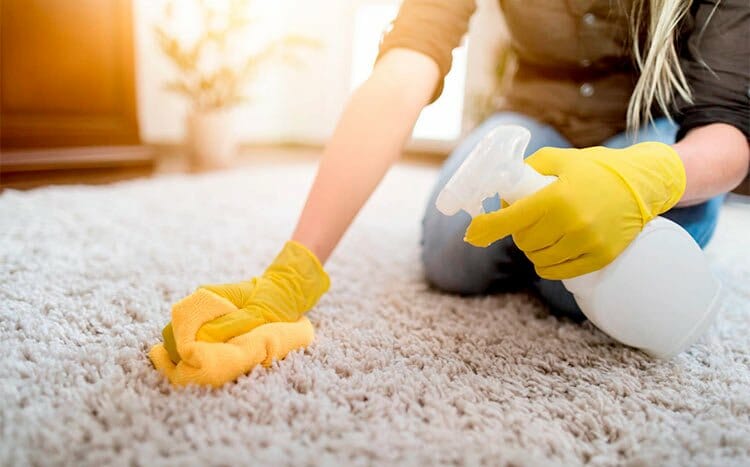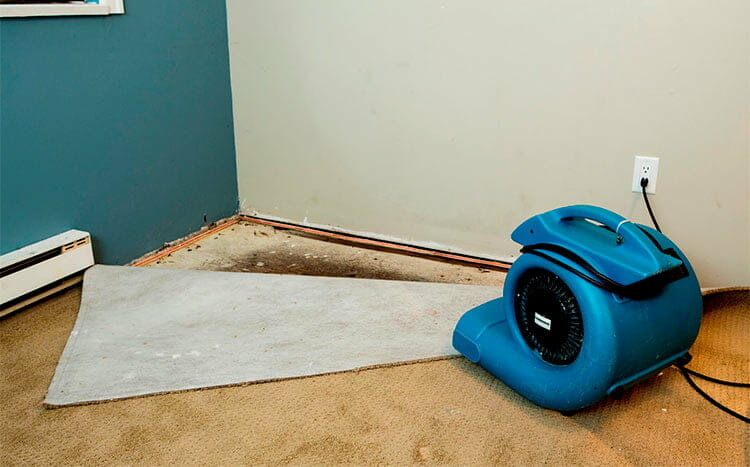Should you discover mold in your carpet, it’s critical to promptly tackle and remove it, as it poses potential risks and could jeopardize the health of you and your family.
To remove mold from the carpet you can use a steam cleaner or a HEPA vacuum along with vinegar and baking soda mix. For large mold issues, using a professional service or replacing carpet is advisable. Less significant growths can be removed with some common household cleaners, while others may require hiring or buying specialist equipment.
This article will provide you with all the tips and tricks to remediate mold in carpet as well as preventing future mold from growing.
Signs your carpet might have mold

In many circumstances, carpet mold falls into that worrying category of hidden mold. This is mold that you can not typically see, but which can still affect your health and your home. Hidden mold can grow beneath paint, behind drywall, inside chimneys, and underneath carpets.
Beside the obvious growths of mold on the surface of your carpet, there are several other signs that your carpet might be growing mold. These include:
- Your carpet smells musty: Mold releases chemical compounds known as microbial volatile organic compounds (MVOCs) as it grows. These odorous gases are responsible for that distinctive musty smell that you typically associate with mold growth (or when you’ve left your washing in the machine for too long!).
- Your carpet feels squishy: Mold can not grow without a moisture source. If you have had some recent flooding in your home, or you live in a poorly ventilated, high humidity environment, your carpet can become damp and squishy. If your carpet is damp, then there is a much stronger chance that it could very quickly become a home for mold growths!
- Your allergies are acting up: If you suddenly start sneezing, wheezing, coughing, or have developed a rash, a mold allergy could be to blame. If there have been no other recent, significant environmental changes in your home, but these symptoms are still cropping up, you may wish to consider getting a skin prick allergy test. If you are allergic to mold, it could be worth having a mold inspection to address the possibility that you are harboring some hidden mold in your carpet (or elsewhere!).
If you notice any of the above signs that might indicate mold carpet, you should seek the advice of a professional mold inspector and remediator to help you address this issue.
Use this FREE service
HomeGardenGuides.com is a free service that quickly matches you with top voted local mold inspection specialists and mold remediators.
Our service will connect you with three certified experts, who will get back to you with quotes and estimates for their services fast. Using this service couldn’t be easier!
- Scroll to the top of the page and enter your zip code.
- Answer questions about your carpet mold inspection job.
- Your details are forwarded to three local experts. They will send you a price estimate for the job and some friendly advice.
IMPORTANT: There is no obligation to hire. This is a free tool and service to be used at your pleasure.

Steps to kill and remove mold in carpet
So, you’re absolutely certain that you have mold growing in your carpet – how should you get rid of it?
If the patch of mold you are trying to remove is only small (less than 3 feet by 3 feet in total), then you should be able to remediate it yourself. Anything larger than this will require the assistance of a mold removal professional.
We have set out a few basic steps below that will help you with your DIY carpet mold remediation.
Step 1: Ventilation
It is crucial that you keep the area you are trying to remediate well ventilated, with plenty of fresh air circulating through it. As you will be using household cleaners to remove the mold, this ventilation will help prevent you from inhaling any fumes, as well as mold spores.
Step 2: Removing surface mold
Using a clean, stiff brush, attempt to remove as much surface mold as possible. Try and catch as much of this visible mold as you can, using some plastic sheeting or a bag. A HEPA vacuum might be handy here, but you will need to thoroughly rinse and clean the vacuum and filter to prevent the further spread of mold spores.
Step 3: Clean the mold affected area
Using a carpet cleaning product, scrub the affected area. Use of bleach is not recommended, as it can damage your carpet. It can be helpful to allow the cleaning solution to soak into the affected area for 10-15 minutes before scrubbing. Repeat this step as necessary.
Step 4: Allow to air dry
Keep the area well ventilated and allow the affected portion of your carpet to completely air dry. You can use a HEPA vacuum on the area once it is dry, but be sure to thoroughly clean your vacuum afterwards, so that it is free of mold spores for the next time you use it.

Tips to prevent mold from forming in carpet
When it comes to preventing mold growth in carpets, or in any other area of your home or property for that matter, the most important thing you can do is keep things dry and free from moisture or dampness.
Mold will not grow without a source of moisture. If you can keep your home dry and well-ventilated, you will be halfway to winning the battle against any stubborn mold spores that might be floating around.
Other tips to keep your carpet mold free include:
- Thoroughly cleaning and drying carpet after a flooding event. Often mold will take hold in your home in the aftermath of a flood. You can prevent this from happening by thoroughly cleaning the flooded area, and making sure it is completely dry. Hiring an industrial dryer or fan can be a helpful hack in this situation.
- Using a dehumidifier. If you live in a particularly damp or humid environment, it can often seem that controlling the moisture in your home is something of an impossible task. Using a dehumidifier can help surmount this problem by helping regulate moisture levels in your home.
Is mold in carpet bad for you?
There is no level of mold growth or mold exposure that can be considered safe. If there is mold growing in your carpet, or anywhere in your home for that matter, you should take immediate steps to remove it.
While some people may experience no obvious ill-effects from exposure to carpet mold, it can prove especially dangerous for those with mold allergies or people who are otherwise susceptible (including the elderly, the young, or asthmatics).
Carpet mold can pose a risk that may not be present in other mold types simply by virtue of growing in the carpet, rather than on the wall or ceiling.
Some of the dangers of mold in your carpet
A unique danger posed by mold in your carpet is the release of mold spores whenever you walk across the carpet. As mold spores are very tiny – microscopic, in fact – and extremely lightweight, they can easily become airborne in such a manner.
As well as causing these mold spores to spread further throughout your home, activity such as walking across mold-infested carpet also means that you are much more likely to inhale airborne mold spores. As the inhalation of mold spores is responsible for many of the ill-effects of mold exposure, this can be quite a serious risk.
Some of the common symptoms of mold spore inhalation from carpet mold can include:
- Respiratory problems
- Runny nose
- Sore throat
- Sneezing
- Coughing
- Wheezing
- Asthma attacks
What if mold is under the carpet?
If the mold growth on your carpet has spread to the underlay, then a simple scrub and vacuum probably won’t be sufficient to fix the issue.
In these circumstances, you will most likely need to replace the entire carpet. Sometimes it might be possible to simply remove and replace a small portion of carpet, rather than removing and replacing an entire wall-to-wall area. In either circumstance, you will need to consult with a mold remediation specialist who will be able to advise you on the best course of action for your particular carpet mold job.
How to get rid of moldy smell after remediation
If you have performed your mold remediation thoroughly and successfully, there should be no lingering, musty smells or odors. If you do notice a persistent moldy smell, you may need to call in a professional mold remediator, as it is possible that you could be dealing with some hidden mold that has been overlooked in your mold removal efforts.
If the smell of the chemicals that were used to remediate the mold problem are hanging around, simply ventilating the area properly can help a great deal. Otherwise, run a steam cleaner over the carpet in question to freshen it up.
DIY vs professional carpet mold remediation
If you are tossing up whether to hire a professional for your mold remediation job, or to simply do it yourself, there are a few considerations you may need to take into account. While some of these may seem more obvious than others, you should try and consider these all in tandem, and make the best and most informed decision for your individual circumstances.
- Cost: This is the most pressing concern for many homeowners, and the one that stops many from hiring professional mold remediators. While it costs significantly less to remove mold yourself (it is often possible to remove mold with common household cleaners), it may end up costing you more in the long run if you ignore or underestimate the severity of your mold growth. If the mold growth you are trying to remediate measures more than ten square feet, or you are in any way concerned that it may be more serious then it appears, then call in the professionals!
- Equipment: If you are DIY-ing mold removal at home, you will only need to use a few common household cleaners and tools that you probably already have lying around. Professional mold removal specialists will make use of specialist chemicals and equipment to remediate your mold problem. This is because they are typically dealing with more heavy duty mold removal jobs that require more intensive equipment.
- Expertise: Lastly, but by no means leastly, comes the question of expertise. A professional mold removal specialist will be able to guide you through the entire remediation process, from identifying the mold growth to disposing of any mold-ridden materials, and all that comes in between. Their experience will allow them to address the mold problem in your home in a comprehensive manner – looking at the source of the mold growth and how to prevent it in future.
Best products for carpet mold removal
If you are looking to DIY remove mold from your carpet, then there are a few great products you should familiarise yourself with.
Best overall
Steam has been proven to be effective in removing mold and killing mold spores, so a steam cleaner can be a powerful tool in remediating small mold growths in your carpet. You will need to steam the affected areas for at least 15 seconds, and ensure that you thoroughly dry the area afterwards to prevent mold from returning.
Best budget
If you’re after a no-frills, no-full budget mold remover for your carpet, then look no further than baking soda and vinegar. This mixture can be applied to your carpet (once you have brushed off the surface mold) and allow it to work it’s magic! It is not as intensive as other chemical cleaners, but will often suffice for minor mold removal jobs.
Best runner up
Using a HEPA vacuum can be a great way to ensure you have removed any traces of pesky, persistent mold spores from your carpet. Although it will not remove mold on it’s own, it is a great companion to the products mentioned above, and can be very effective when used correctly.








